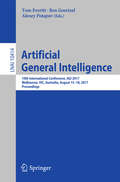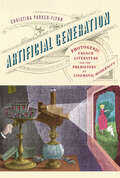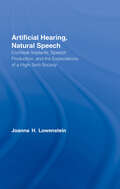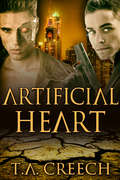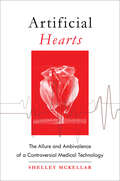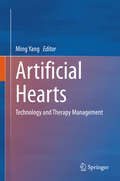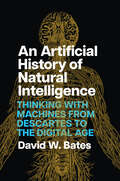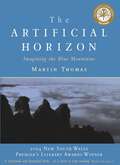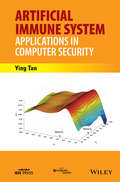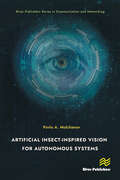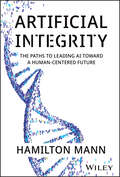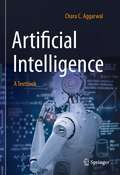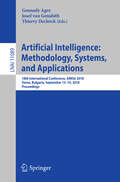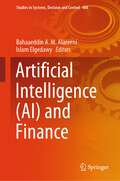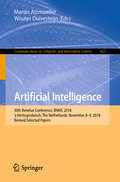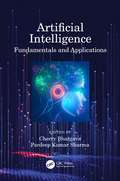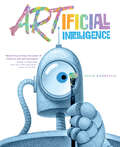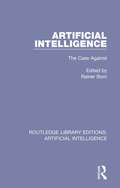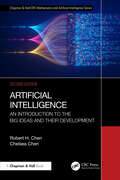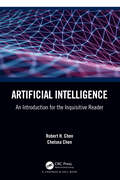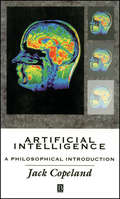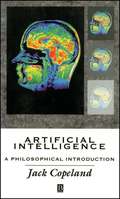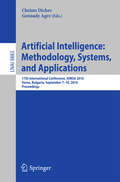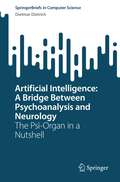- Table View
- List View
Artificial General Intelligence: 10th International Conference, AGI 2017, Melbourne, VIC, Australia, August 15-18, 2017, Proceedings (Lecture Notes in Computer Science #10414)
by Tom Everitt, Ben Goertzel and Alexey PotapovThis book constitutes the proceedings of the 10th International Conference on Artificial General Intelligence, AGI 2017, held in Melbourne, VIC, Australia, in August 2017. The 24 regular papers presented in this book together with 1 short paper were carefully reviewed and selected from 35 submissions. They cover topics such as architectures; mathematical foundations; algorithms; safety; understanding; human cognition; and philosophy.
Artificial Generation: Photogenic French Literature and the Prehistory of Cinematic Modernity
by Christina Parker-FlynnArtificial Generation: Photogenic French Literature and the Prehistory of Cinematic Modernity investigates the intersection of film theory and nineteenth-century literature, arguing that the depth of amalgamation that occurred within literary representation during this era aims to replicate an illusion of life and its sensations, in ways directly related to broader transitions into our modern cinematic age. A key part of this evolution in representation relies on the continual re-emergence of the artificial woman as longstanding expression of masculine artistic subjectivity, which, by the later nineteenth century, becomes a photographic and filmic drive. Moving through the beginning of film history, from Georges Méliès and other “silent” filmmakers in the 1890s, into more contemporary movies, including Alfred Hitchcock’s Vertigo (1958) and Blade Runner 2049 (2017), the book analyzes how films are often structured around the prior century’s mythic and literary principles, which now serve as foundation for film as medium—a phantom form for life’s re-presentation. Artificial Generation provides a crucial reassessment of the longstanding, mutual exchange between cinematic and literary reproduction, offering an innovative perspective on the proto-cinematic imperative of simulation within nineteenth-century literary symbolism.
Artificial Hearing, Natural Speech: Cochlear Implants, Speech Production, and the Expectations of a High-Tech Society (Outstanding Dissertations in Linguistics)
by Joanna Hart LowensteinThis book explores the interface between speech perception and production through a longitudinal acoustic analysis of the speech of postlingually deaf adults with cochlear implants (electrode and computer prostheses for the inner ear in cases of nerve deafness). The methodology is based on the work of Joseph Perkell at MIT, replicating and extending analysis to subjects with modern digital cochlear implants and processor technology. Lowenstein also examines how cochlear implants are portrayed in dramatic and documentary television programs, the scientific accuracy of those portrayals, and what expectations might be taken away by viewers, particularly given modern society's view that technology can overcome the frailties of the human body.
Artificial Heart
by T. A. CreechIn a future where the United States is slowly rebuilding itself, Omega Travis Danten is a big city cop sent to a seemingly desolate city on the edge of the Waste. This desert is full of undesirables, and it’s only a matter of time before they wreak havoc. But, Omegas are always assigned Alphas, and his new partner’s job is to protect him.But SdAI Alpha Virgil is not at all amused with the partner who chose him. Travis is willful and naive to the dangers a homicide detective faces here, and it makes Virgil’s job that much harder. And Travis, of course, is human and develops feelings, feelings that go beyond the rules about Omega/Alpha partnerships.Travis and Virgil have to find common ground, find a killer, and find space for each other in their own hearts, even if one is artificial.
Artificial Hearts: The Allure and Ambivalence of a Controversial Medical Technology
by Shelley McKellarA comprehensive history of the development of artificial hearts in the United States.Artificial hearts are seductive devices. Their promissory nature as a cure for heart failure aligned neatly with the twentieth-century American medical community’s view of the body as an entity of replacement parts. In Artificial Hearts, Shelley McKellar traces the controversial history of this imperfect technology beginning in the 1950s and leading up to the present day. McKellar profiles generations of researchers and devices as she traces the heart’s development and clinical use. She situates the events of Dr. Michael DeBakey and Dr. Denton Cooley’s professional fall-out after the first artificial heart implant case in 1969, as well as the 1982–83 Jarvik-7 heart implant case of Barney Clark, within a larger historical trajectory. She explores how some individuals—like former US Vice President Dick Cheney—affected the public profile of this technology by choosing to be implanted with artificial hearts. Finally, she explains the varied physical experiences, both negative and positive, of numerous artificial heart recipients. McKellar argues that desirability—rather than the feasibility or practicality of artificial hearts—drove the invention of the device. Technical challenges and unsettling clinical experiences produced an ambivalence toward its continued development by many researchers, clinicians, politicians, bioethicists, and the public. But the potential and promise of the artificial heart offset this ambivalence, influencing how success was characterized and by whom. Packed with larger-than-life characters—from dedicated and ardent scientists to feuding Texas surgeons and brave patients—this book is a fascinating case study that speaks to questions of expectations, limitations, and uncertainty in a high-technology medical world.
Artificial Hearts: Technology and Therapy Management
by Ming YangThis book provides a comprehensive introduction to artificial hearts, summarizing the latest advances in basic technologies, design, evaluation, and management. Featuring 11 chapters, it discusses the origins of the artificial heart, the mechanisms of heart failure, and the principles of artificial heart technologies. Further, it offers an overview of rotary pumps and volume-displacement pumps, and addresses total artificial hearts. Lastly, the book covers evaluation, selection, therapy management, challenges, and the latest innovations. Given its scope, it is a valuable resource for researchers and technicians in the area of biomedical engineering, as well as surgeons.
Artificial Hells
by Claire BishopSince the 1990s, critics and curators have broadly accepted the notion that participatory art is the ultimate political art: that by encouraging an audience to take part an artist can promote new emancipatory social relations. Around the world, the champions of this form of expression are numerous, ranging from art historians such as Grant Kester, curators such as Nicolas Bourriaud and Nato Thompson, to performance theorists such as Shannon Jackson.Artificial Hells is the first historical and theoretical overview of socially engaged participatory art, known in the US as "social practice." Claire Bishop follows the trajectory of twentieth-century art and examines key moments in the development of a participatory aesthetic. This itinerary takes in Futurism and Dada; the Situationist International; Happenings in Eastern Europe, Argentina and Paris; the 1970s Community Arts Movement; and the Artists Placement Group. It concludes with a discussion of long-term educational projects by contemporary artists such as Thomas Hirschhorn, Tania Bruguera, Pawe? Althamer and Paul Chan.Since her controversial essay in Artforum in 2006, Claire Bishop has been one of the few to challenge the political and aesthetic ambitions of participatory art. In Artificial Hells, she not only scrutinizes the emancipatory claims made for these projects, but also provides an alternative to the ethical (rather than artistic) criteria invited by such artworks. Artificial Hells calls for a less prescriptive approach to art and politics, and for more compelling, troubling and bolder forms of participatory art and criticism.
An Artificial History of Natural Intelligence: Thinking with Machines from Descartes to the Digital Age
by David W. BatesA new history of human intelligence that argues that humans know themselves by knowing their machines. We imagine that we are both in control of and controlled by our bodies—autonomous and yet automatic. This entanglement, according to David W. Bates, emerged in the seventeenth century when humans first built and compared themselves with machines. Reading varied thinkers from Descartes to Kant to Turing, Bates reveals how time and time again technological developments offered new ways to imagine how the body’s automaticity worked alongside the mind’s autonomy. Tracing these evolving lines of thought, An Artificial History of Natural Intelligence offers a new theorization of the human as a being that is dependent on technology and produces itself as an artificial automaton without a natural, outside origin.
Artificial Horizon
by Thomas, MartinMartin Thomas takes the reader on a journey through a compelling study of culture, landscape and mythology. For both Aboriginal people and their colonisers, the rugged landscape of the Blue Mountains has stood as an intriguing riddle and a stimulus to the imagination. The author evokes this dramatic and bewildering landscape and leads his readers through the cultural history of the locality in order to probe the 'dreamwork of imperialism'.
Artificial Immune System: Applications in Computer Security
by Ying TanThis book deals with malware detection in terms of Artificial Immune System (AIS), and presents a number of AIS models and immune-based feature extraction approaches as well as their applications in computer security. Covers all of the current achievements in computer security based on immune principles, which were obtained by the Computational Intelligence Laboratory of Peking University, China. Includes state-of-the-art information on designing and developing artificial immune systems (AIS) and AIS-based solutions to computer security issues. Presents new concepts such as immune danger theory, immune concentration, and class-wise information gain (CIG).
Artificial Insect-Inspired Vision for Autonomous Systems (River Publishers Series in Communications and Networking)
by Pavlo A. MolchanovThis book offers a straightforward explanation of groundbreaking artificial vision technology, which can provide limitless scalable resolution and lens-less, human-like vision with electronic control over focus, field of view, and direction. This advanced technology addresses the challenge of rapidly transferring large volumes of visual data for remote imaging systems.It also presents the novel artificial eye concept, the foundation of this vision technology. This eye can serve as a wearable device for visually impaired individuals, eliminating the need for surgery or implants. It offers significant advancements in long-distance vision with high resolution and automatic recognition of surrounding objects.The book also provides a concise overview of the architecture and benefits of nature-inspired antenna arrays and their potential applications, enhancing the reader’s understanding and the importance of the presented vision technology.Richly illustrated with colorful diagrams and straightforward explanations, this book is designed to facilitate understanding for readers with engineering backgrounds, customers, and students.
Artificial Integrity: The Paths to Leading AI Toward a Human-Centered Future
by Hamilton MannNavigating the transitions to the future of AI—Integrity over Intelligence Envision a world where artificial intelligence can deliver integrity-led outcomes seamlessly, adapting to diverse cultural context, value models, and situational nuances, countering subconscious biases, all while operating in an advanced human-centered manner. This is the promise of Artificial Integrity. In Artificial Integrity, digital strategist, technologist, doctoral researcher, acclaimed management thinker, and seasoned business executive Hamilton Mann emphasizes that the challenge of AI is in ensuring systems that exhibit integrity-led capabilities over the pursuit of mere general or super intelligence. Mann tackles the inadequacies of traditional ethical frameworks in handling the complexities of new AI technologies to make them trustworthy and reliable as they profoundly impact human lives. Introducing the transformative concept of “artificial integrity,” Mann proposes a paradigm shift, defining a “code of design” to ensure AI systems align with, amplify, and sustain human values and societal norms, maximizing integrity-led AI outcomes. Artificial Integrity discusses practical insights into driving a future where AI enhances, without replacing, human capabilities while being inclusive and reflective of diverse human experiences, emphasizing human agency. The book offers: Guiding posts and step-by-step solutions for designing, implementing and continuously aligning AI development to responsibly advance human and artificial co-intelligence Strategies and actionable advice for integrating AI into business and societal structures Practical paths toward managing the transition to the future of AI for human productivity and decision-making while maintaining sustainable trustworthiness Artificial Integrity is essential for anyone involved in AI development, from executives, business leaders, and managers to entrepreneurs, tech enthusiasts and policymakers. It's also perfect for laypeople interested in how AI intersects with society. Dive into this compelling and thought provoking read to ensure you are prepared for the challenges and opportunities that lie ahead in a human-centered AI-driven future.
Artificial Intelligence: A Textbook
by Charu C. AggarwalThis textbook covers the broader field of artificial intelligence. The chapters for this textbook span within three categories:Deductive reasoning methods: These methods start with pre-defined hypotheses and reason with them in order to arrive at logically sound conclusions. The underlying methods include search and logic-based methods. These methods are discussed in Chapters 1through 5.Inductive Learning Methods: These methods start with examples and use statistical methods in order to arrive at hypotheses. Examples include regression modeling, support vector machines, neural networks, reinforcement learning, unsupervised learning, and probabilistic graphical models. These methods are discussed in Chapters~6 through 11. Integrating Reasoning and Learning: Chapters~11 and 12 discuss techniques for integrating reasoning and learning. Examples include the use of knowledge graphs and neuro-symbolic artificial intelligence.The primary audience for this textbook are professors and advanced-level students in computer science. It is also possible to use this textbook for the mathematics requirements for an undergraduate data science course. Professionals working in this related field many also find this textbook useful as a reference.
Artificial Intelligence: 18th International Conference, AIMSA 2018, Varna, Bulgaria, September 12–14, 2018, Proceedings (Lecture Notes in Computer Science #11089)
by Gennady Agre Josef Van Genabith Thierry DeclerckThis book constitutes the refereed proceedings of the 18th International Conference on Artificial Intelligence: Methodology, Systems, and Applications, AIMSA 2018, held in Varna, Bulgaria, in September 2018.The 22 revised full papers and 7 poster papers presented were carefully reviewed and selected from 72 submissions. They cover a wide range of topics in AI: from machine learning to natural language systems, from information extraction to text mining, from knowledge representation to soft computing; from theoretical issues to real-world applications.
Artificial Intelligence (Studies in Systems, Decision and Control #488)
by Bahaaeddin A. M. Alareeni Islam ElgedawyArtificial intelligence (AI) has the potential to significantly improve efficiency, reduce costs, and increase the speed and accuracy of financial decision-making, making it an increasingly important tool for financial professionals. One way that AI can improve efficiency in finance is by automating tasks and processes that are time-consuming and repetitive for humans. For example, AI algorithms can be used to analyze and process large amounts of data, such as financial statements and market data, in a fraction of the time that it would take a human to do so. This can allow financial professionals to focus on higher-value tasks, such as interpreting data and making strategic decisions, rather than being bogged down by mundane tasks. AI can also reduce costs in finance by increasing automation and eliminating the need for certain tasks to be performed manually. This can result in cost savings for financial institutions, which can then be passed on to customers in the form of lower fees or better services. AI can be used to identify unusual patterns of activity that may indicate fraudulent behavior. This can help financial institutions reduce losses from fraud and improve customer security. AI-powered chatbots and virtual assistants can help financial institutions provide faster, more efficient customer service, particularly when it comes to answering common questions and handling routine tasks. Some financial institutions are using AI to analyze market data and make trades in real-time. AI-powered trading algorithms can potentially make faster and more accurate trading decisions than humans. In terms of speed and accuracy, AI algorithms can analyze data and make decisions much faster than humans, and can do so with a high degree of accuracy. This can be particularly useful in fast-moving financial markets, where quick and accurate decision-making can be the difference between success and failure.This book highlights how AI in finance can improve efficiency, reduce costs, and increase the speed and accuracy of financial decision-making. Moreover, the book also focuses on how to ensure the responsible and ethical use of AI in finance.This book is a valuable resource for students, scholars, academicians, researchers, professionals, executives, government agencies, and policymakers interested in exploring the role of artificial intelligence (AI) in finance. Its goal is to provide a comprehensive overview of the latest research and knowledge in this area, and to stimulate further inquiry and exploration.
Artificial Intelligence: 30th Benelux Conference, BNAIC 2018, ‘s-Hertogenbosch, The Netherlands, November 8–9, 2018, Revised Selected Papers (Communications in Computer and Information Science #1021)
by Martin Atzmueller Wouter DuivesteijnThis book contains a selection of the best papers of the 30th Benelux Conference on Artificial Intelligence, BNAIC 2018, held in ‘s-Hertogenbosch, The Netherlands, in November 2018. The 9 full papers and 3 short papers presented in this volume were carefully reviewed and selected from 31 submissions. They address various aspects of artificial intelligence such as natural language processing, agent technology, game theory, problem solving, machine learning, human-agent interaction, AI and education, and data analysis.
Artificial Intelligence: Fundamentals and Applications
by Cherry Bhargava Pradeep Kumar SharmaThis comprehensive reference text discusses the fundamental concepts of artificial intelligence and its applications in a single volume. Artificial Intelligence: Fundamentals and Applications presents a detailed discussion of basic aspects and ethics in the field of artificial intelligence and its applications in areas, including electronic devices and systems, consumer electronics, automobile engineering, manufacturing, robotics and automation, agriculture, banking, and predictive analysis. Aimed at senior undergraduate and graduate students in the field of electrical engineering, electronics engineering, manufacturing engineering, pharmacy, and healthcare, this text: Discusses advances in artificial intelligence and its applications. Presents the predictive analysis and data analysis using artificial intelligence. Covers the algorithms and pseudo-codes for different domains. Discusses the latest development of artificial intelligence in the field of practical speech recognition, machine translation, autonomous vehicles, and household robotics. Covers the applications of artificial intelligence in fields, including pharmacy and healthcare, electronic devices and systems, manufacturing, consumer electronics, and robotics.
ARTificial Intelligence
by David BiedrzyckiEver since he was a little chip, Robot knew he was ART-ificially different. A funny and heartfelt picture book exploring AI, art, and creativity.Try as he might, Robot can't keep up with the other robots at the warehouse. But when he's sent off for reprogramming, he takes a wrong turn and ends up encountering music, dancing, and ART! He tries to share his discovery, only to find that art is hard to explain—and even harder to do. Will Robot learn to express himself and transform the warehouse . . . or will he be recycled?
Artificial Intelligence: The Case Against (Routledge Library Editions: Artificial Intelligence #3)
by Rainer BornThe purpose of this book, originally published in 1987, was to contribute to the advance of artificial intelligence (AI) by clarifying and removing the major sources of philosophical confusion at the time which continued to preoccupy scientists and thereby impede research. Unlike the vast majority of philosophical critiques of AI, however, each of the authors in this volume has made a serious attempt to come to terms with the scientific theories that have been developed, rather than attacking superficial ‘straw men’ which bear scant resemblance to the complex theories that have been developed. For each is convinced that the philosopher’s responsibility is to contribute from his own special intellectual point of view to the progress of such an important field, rather than sitting in lofty judgement dismissing the efforts of their scientific peers. The aim of this book is thus to correct some of the common misunderstandings of its subject. The technical term Artificial Intelligence has created considerable unnecessary confusion because of the ordinary meanings associated with it, and for that very reason, the term is endlessly misused and abused. The essays collected here all aim to expound the true nature of AI, and to remove the ill-conceived philosophical discussions which seek answers to the wrong questions in the wrong ways. Philosophical discussions and decisions about the proper use of AI need to be based on a proper understanding of the manner in which AI-scientists achieve their results; in particular, in their dependence on the initial planning input of human beings. The collection combines the Anglo-Saxon school of analytical philosophy with scientific and psychological methods of investigation. The distinguished authors in this volume represent a cross-section of philosophers, psychologists, and computer scientists from all over the world. The result is a fascinating study in the nature and future of AI, written in a style which is certain to appeal and inform laymen and specialists alike.
Artificial Intelligence: An Introduction to the Big Ideas and their Development (Chapman & Hall/CRC Mathematics and Artificial Intelligence Series)
by Robert H. Chen Chelsea ChenArtificial Intelligence: An Introduction to Big Ideas and their Development, Second Edition guides readers through the history and development of artificial intelligence (AI), from its early mathematical beginnings through to the exciting possibilities of its potential future applications. To make this journey as accessible as possible, the authors build their narrative around accounts of some of the more popular and well-known demonstrations of artificial intelligence, including Deep Blue, AlphaGo and even Texas Hold’em, followed by their historical background, so that AI can be seen as a natural development of the mathematics and computer science of AI. As the book proceeds, more technical descriptions are presented at a pace that should be suitable for all levels of readers, gradually building a broad and reasonably deep understanding and appreciation for the basic mathematics, physics, and computer science that is rapidly developing artificial intelligence as it is today. Features Only mathematical prerequisite is an elementary knowledge of calculus. Accessible to anyone with an interest in AI and its mathematics and computer science. Suitable as a supplementary reading for a course in AI or the History of Mathematics and Computer Science in regard to artificial intelligence. New to the Second Edition Fully revised and corrected throughout to bring the material up-to-date. Greater technical detail and exploration of basic mathematical concepts, while retaining the simplicity of explanation of the first edition. Entirely new chapters on large language models (LLMs), ChatGPT, and quantum computing.
Artificial Intelligence: An Introduction for the Inquisitive Reader
by Robert H. Chen Chelsea C. ChenArtificial Intelligence: An Introduction for the Inquisitive Reader guides readers through the history and development of AI, from its early mathematical beginnings through to the exciting possibilities of its potential future applications. To make this journey as accessible as possible, the authors build their narrative around accounts of some of the more popular and well-known demonstrations of artificial intelligence including Deep Blue, AlphaGo and even Texas Hold’em, followed by their historical background, so that AI can be seen as a natural development of mathematics and computer science. As the book moves forward, more technical descriptions are presented at a pace that should be suitable for all levels of readers, gradually building a broad and reasonably deep understanding and appreciation for the basic mathematics, physics, and computer science that is rapidly developing artificial intelligence as it is today. Features Only mathematical prerequisite is an elementary knowledge of calculus Accessible to anyone with an interest in AI and its mathematics and computer science Suitable as a supplementary reading for a course in AI or the History of Mathematics and Computer Science in regard to artificial intelligence.
Artificial Intelligence: A Philosophical Introduction
by Jack CopelandPresupposing no familiarity with the technical concepts of either philosophy or computing, this clear introduction reviews the progress made in AI since the inception of the field in 1956. Copeland goes on to analyze what those working in AI must achieve before they can claim to have built a thinking machine and appraises their prospects of succeeding. There are clear introductions to connectionism and to the language of thought hypothesis which weave together material from philosophy, artificial intelligence and neuroscience. John Searle's attacks on AI and cognitive science are countered and close attention is given to foundational issues, including the nature of computation, Turing Machines, the Church-Turing Thesis and the difference between classical symbol processing and parallel distributed processing. The book also explores the possibility of machines having free will and consciousness and concludes with a discussion of in what sense the human brain may be a computer.
Artificial Intelligence: A Philosophical Introduction
by Jack CopelandPresupposing no familiarity with the technical concepts of either philosophy or computing, this clear introduction reviews the progress made in AI since the inception of the field in 1956. Copeland goes on to analyze what those working in AI must achieve before they can claim to have built a thinking machine and appraises their prospects of succeeding. There are clear introductions to connectionism and to the language of thought hypothesis which weave together material from philosophy, artificial intelligence and neuroscience. John Searle's attacks on AI and cognitive science are countered and close attention is given to foundational issues, including the nature of computation, Turing Machines, the Church-Turing Thesis and the difference between classical symbol processing and parallel distributed processing. The book also explores the possibility of machines having free will and consciousness and concludes with a discussion of in what sense the human brain may be a computer.
Artificial Intelligence: 17th International Conference, AIMSA 2016, Varna, Bulgaria, September 7-10, 2016, Proceedings (Lecture Notes in Computer Science #9883)
by Christo Dichev Gennady AgreThis book constitutes the refereed proceedings of the 17th International Conference on Artificial Intelligence: Methodology, Systems, and Applications, AIMSA 2016, held in Varna, Bulgaria in September 2015. The 32 revised full papers 6 poster papers presented were carefully reviewed and selected from 86 submissions. They cover a wide range of topics in AI: from machine learning to natural language systems, from information extraction to text mining, from knowledge representation to soft computing; from theoretical issues to real-world applications.
Artificial Intelligence: The Psi-Organ in a Nutshell (SpringerBriefs in Computer Science)
by Dietmar DietrichTo be able to merge the psyche with the neural system has been a long-sought goal. There is much scientific literature on results from research on this topic, but the goal of this “booklet” is to present the subject in a nutshell and to attract a wider audience to this highly complex topic. Scientists often need years to grasp the scope and implications of merging the psyche with the neural system. Does that really have to be the case? What does the simulated model look like? What are the underlying philosophies? Can it be understood without mathematical formalism? Uniting the psyche and neurology in one model, on the one hand, allows psychological and social theories to be tested on a scientific basis using simulation experiments. On the other hand, a model developed according to the functional structures of the human brain, let us call it the Psi-Organ, which comprises neurology and psyche as one unit, can serve as a basis for AI systems. These can be systems with cognitive capabilities that save human lives, save energy, ensure safety at airports, provide support in caring for the elderly and much more. In other words, systems that can simplify our lives in the most relevant ways and on a broad basis. This model, the Psi-Organ, goes far beyond today's primarily behavior-based AI methods. The manuscript can serve as an excellent introduction to the problem of understanding and modelling the human mind, and to the problem of achieving artificial “intelligence” in general, increasing awareness and understanding for the associated challenges. In that regard, it is a valuable supplementary text for advanced students or researchers in the field, notably not only in AI, but also (and perhaps primarily) in the medical fields.
